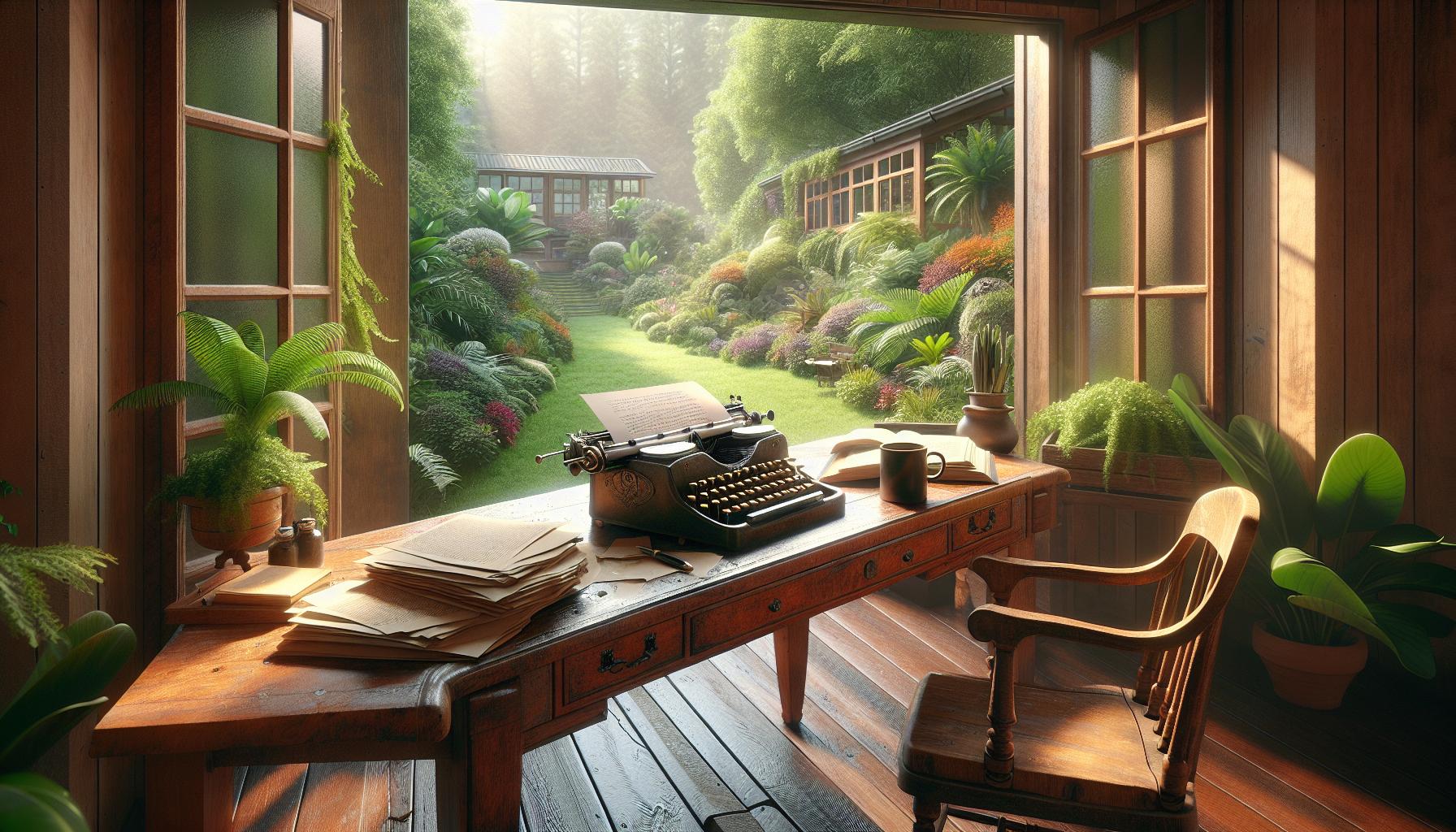When it comes to narrative writing, the line between fiction and nonfiction often blurs like a watercolor painting in the rain. Many writers and readers find themselves scratching their heads wondering which category their stories fall into. It’s not always as simple as labeling a piece “true” or “made-up.”
The beauty of narrative writing lies in its versatility – it can swing both ways. Whether you’re crafting an imaginative tale about dragons and wizards or recounting your grandmother’s journey across continents during wartime, narrative writing serves as the backbone of storytelling. This creative approach to writing has evolved over centuries to become a powerful tool for both factual accounts and fictional adventures.
Understanding Narrative Writing Fundamentals
Narrative writing creates a sequence of events through structured storytelling elements. This form of writing uses specific techniques to engage readers regardless of genre classification.
Key Elements of Narrative Writing
A narrative structure contains five essential components: plot, characters, setting, conflict and theme. The plot drives the story forward through exposition, rising action, climax, falling action and resolution. Characters serve as the story’s participants, featuring protagonists, antagonists and supporting roles who interact within the narrative framework. Settings establish time and place, creating a contextual environment for events to unfold. Conflict generates tension through internal struggles or external obstacles. Themes emerge as underlying messages or universal truths that connect readers to deeper meanings.
The Art of Storytelling Techniques
Effective storytelling employs descriptive language, dialogue and pacing to create immersive experiences. Writers use sensory details to paint vivid scenes, allowing readers to visualize environments and emotional states. Dialogue reveals character personalities while advancing plot points through natural conversations. Pacing controls narrative rhythm through varied sentence structures, paragraph lengths and scene transitions. Literary devices like foreshadowing, flashbacks and symbolism add depth to narratives. Point of view determines perspective, with first-person offering intimate insights and third-person providing broader storytelling scope.
Exploring Fiction in Narrative Writing

Fiction in narrative writing creates imaginary worlds through carefully crafted storytelling elements. The creative process transforms abstract ideas into compelling narratives that resonate with readers through vivid descriptions character development.
Creative Elements and Imagination
Fictional narratives incorporate unique creative elements that distinguish them from factual accounts. Writers employ metaphors symbolism literary devices to enhance the storytelling experience. The narrative landscape expands through world-building techniques, creating detailed settings from scratch. Artistic license allows authors to bend reality, introducing supernatural elements mythical creatures alternate histories. Descriptive language paints mental pictures, transforming abstract concepts into tangible scenes that readers can visualize experience emotionally.
Character Development and Plot Structure
Character arcs drive fictional narratives forward through systematic evolution growth. Protagonists face internal external conflicts that shape their personalities motivations throughout the story. The plot unfolds through strategic story beats: inciting incidents rising action climactic moments falling action resolution. Authors craft backstories personality traits relationships to create three-dimensional characters that feel authentic relatable. Each scene serves multiple purposes: advancing the plot revealing character traits building tension establishing themes. Writers weave subplots secondary character arcs into the main narrative to create depth complexity.
Examining Nonfiction Narrative Writing
Nonfiction narrative writing presents factual stories through engaging storytelling techniques. This form of writing combines journalistic accuracy with creative elements to deliver real-world accounts that captivate readers while maintaining truthfulness.
Personal Essays and Memoirs
Personal essays and memoirs capture authentic life experiences through first-person narratives. Authors like Joan Didion and David Sedaris craft compelling stories from their lived experiences, documenting significant events, relationships, and personal growth. Memoirs focus on specific periods or themes in an author’s life, such as Maya Angelou’s “I Know Why the Caged Bird Sings,” which explores her childhood experiences. These narratives incorporate dialogue, scene-setting, and character development while adhering to factual accuracy. Personal essays often blend reflection with cultural commentary, creating connections between individual experiences and broader societal themes.
Journalistic Narratives
Journalistic narratives transform investigative reporting into compelling storytelling experiences. Publications like The New Yorker and The Atlantic feature long-form articles that combine thorough research with narrative techniques. Writers such as Tom Wolfe and Gay Talese pioneered New Journalism, incorporating scene-by-scene construction and detailed dialogue in their reporting. These narratives present real events through carefully structured plots, developed characters, and atmospheric descriptions. Journalists conduct extensive interviews, gather documentation, and verify facts to ensure accuracy while maintaining reader engagement through storytelling elements like pacing and tension.
The Blurred Lines Between Fiction and Nonfiction
Narrative writing exists in a spectrum between pure fiction and strict nonfiction, creating zones where storytelling techniques overlap. These intersections produce rich literary territories where authors blend factual accuracy with creative storytelling methods.
Creative Nonfiction as a Hybrid Genre
Creative nonfiction emerges as a distinct form that combines factual reporting with narrative techniques traditionally associated with fiction. Authors like John McPhee pioneered this approach in works such as “Coming into the Country,” using scene-setting, character development and dialogue to enhance real-world stories. Literary magazines including “Creative Nonfiction” showcase pieces that document actual events through lyrical prose, detailed descriptions and carefully structured narratives. This genre encompasses personal essays, literary journalism and biographical works that maintain truthfulness while employing fictional devices to engage readers.
Balancing Truth and Artistic Expression
Authors navigate complex ethical considerations when crafting narratives based on real events. Writers like Truman Capote in “In Cold Blood” demonstrated how to reconstruct actual events using fictional techniques while maintaining journalistic integrity. The Association of Writers & Writing Programs establishes guidelines for creative nonfiction that emphasize factual accuracy alongside artistic presentation. Essential elements include verifiable facts, transparent research methods and clear distinctions between documented events and reconstructed scenes. Authors employ composite characters, compressed timelines and reconstructed dialogue to create compelling narratives without compromising the fundamental truth of their stories.
Best Practices for Narrative Writers
Narrative writers enhance their storytelling through proven techniques that strengthen both fiction and nonfiction works. These practices create engaging narratives that resonate with readers across genres.
Choosing Your Genre
Genre selection shapes the narrative approach writers take in crafting their stories. Fiction genres include mystery, romance, fantasy, science fiction or literary fiction, each with distinct conventions and reader expectations. Nonfiction encompasses memoirs, personal essays, literary journalism or historical narratives that demand factual accuracy. Writers evaluate their source material to determine the most effective genre – fictional stories spring from imagination while nonfiction relies on research documentation interviews. The genre choice influences key decisions about narrative structure, character development, dialogue usage and descriptive techniques.
Maintaining Authenticity
Authentic narratives connect with readers through genuine voices, believable details and emotional truth. Fiction writers create authenticity by developing consistent characters, establishing clear motivations and building coherent story worlds. Nonfiction writers maintain credibility through meticulous fact-checking, accurate dialogue reconstruction and transparent sourcing. Writers integrate sensory details strategically to immerse readers in scenes without overwhelming them. Character actions match established personalities rather than serving plot convenience. Dialogue reflects natural speech patterns while advancing story elements. Research validates setting details, historical context and technical information regardless of genre.
Conclusion
Narrative writing stands as a dynamic form of expression that transcends the traditional boundaries between fiction and nonfiction. Its power lies in the ability to tell compelling stories whether they spring from imagination or real-life experiences.
The distinction between fiction and nonfiction in narrative writing isn’t always clear-cut. Writers often blend elements from both worlds creating rich tapestries of storytelling that engage readers while serving different purposes. What matters most is the authenticity and impact of the story being told.
The future of narrative writing continues to evolve with new forms emerging that challenge conventional categorizations. As long as writers maintain their commitment to craft and truth whether in fiction or nonfiction the art of storytelling will continue to captivate audiences worldwide.
